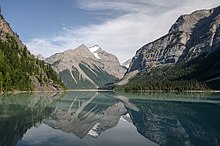water that sits or flows above the earth. including lakes. oceans. rivers. and streams (contrast with groundwater).
Surface water is water located on top of land, forming terrestrial (surrounding by land on all sides) waterbodies, and may also be referred to as blue water, opposed to the seawater and waterbodies like the ocean.

The vast majority of surface water is produced by precipitation. As the climate warms in the spring, snowmelt runs off towards nearby streams and rivers contributing towards a large portion of human drinking water. Levels of surface water lessen as a result of evaporation as well as water moving into the ground becoming ground-water. Alongside being used for drinking water, surface water is also used for irrigation, wastewater treatment, livestock, industrial uses, hydropower, and recreation. For USGS water-use reports, surface water is considered freshwater when it contains less than 1,000 milligrams per liter (mg/L) of dissolved solids.
There are three major types of surface water. Permanent (perennial) surface waters are present year round, and includes lakes, rivers and wetlands (marshes and swamps). Semi-permanent (ephemeral) surface water refers to bodies of water that are only present at certain times of the year including seasonally dry channels such as creeks, lagoons and waterholes. Human-made surface water is water that can be continued by infrastructures that humans have assembled. This would be dammed artificial lakes, canals and artificial ponds (e.g. garden ponds) or swamps. The surface water held by dams can be used for renewable energy in the form of hydropower. Hydropower is the forcing of surface water sourced from rivers and streams to produce energy.

